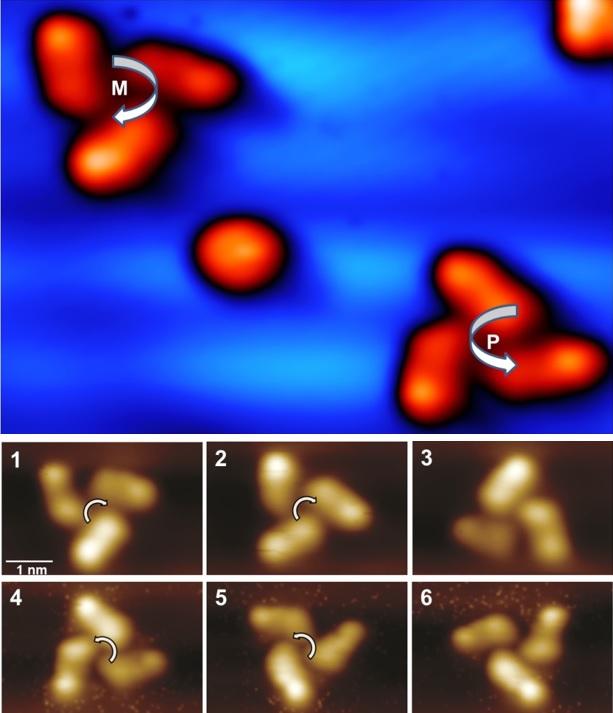OHIO professor Hla develops robust molecular propeller for unidirectional rotations

A look at how the propeller is made up and the unidirectional rotations. Credit: Saw-Wai Hla
In nature, molecule propellers are vital in many biological applications ranging from the swimming bacteria to intracellular transport, but synthetic molecular propellers, like what has been developed, are able to operate in harsher environments and under a precise control.
This new development is a multiple component molecular propeller specially designed to operate on solid surfaces. This tiny propeller is composed of three components; a ratchet shape molecular gear as a base, a tri-blade propeller, and a ruthenium atom acting as an atomic ball bearing that connects the two. The size of the propeller is only about 2 nanometers (nm) wide and 1 nm tall.
“What is special about our propeller is its multi-component design that becomes chiral on the gold crystal surface, i.e. it forms right- or left-tilted gears,” said Hla. “This chirality dictates the rotational direction when energized.”
Hla and his team have also been able to mechanically manipulate and record the molecule's stepwise rotations. This enables them to understand the detail motions at the single molecule level, allowing a direct visualization of the rotation of the individual molecular propellers from images acquired at each rotation steps.
The rotation occurs by an applied electric field, by transfer of electron energy or by mechanical force with a scanning tunneling microscope tip. Through this supply of power, scientists can control the rotation and switch off the propeller by denying it any energy.
Although the molecular propeller developed here is to investigate for the fundamental understanding of its operation, such molecular propellers may find potential applications from catalysts to medicine.
Molecular machines have recently become a trending topic in nanotechnology, with interest in this area of research rising when the 2016 Nobel Prize in Chemistry was awarded for the “design and synthesis of molecular machines.”
###
Hla's paper “A chiral molecular propeller designed for unidirectional rotations on a surface” has been published in Nature Communications.
Media Contact
All latest news from the category: Life Sciences and Chemistry
Articles and reports from the Life Sciences and chemistry area deal with applied and basic research into modern biology, chemistry and human medicine.
Valuable information can be found on a range of life sciences fields including bacteriology, biochemistry, bionics, bioinformatics, biophysics, biotechnology, genetics, geobotany, human biology, marine biology, microbiology, molecular biology, cellular biology, zoology, bioinorganic chemistry, microchemistry and environmental chemistry.
Newest articles

A universal framework for spatial biology
SpatialData is a freely accessible tool to unify and integrate data from different omics technologies accounting for spatial information, which can provide holistic insights into health and disease. Biological processes…

How complex biological processes arise
A $20 million grant from the U.S. National Science Foundation (NSF) will support the establishment and operation of the National Synthesis Center for Emergence in the Molecular and Cellular Sciences (NCEMS) at…

Airborne single-photon lidar system achieves high-resolution 3D imaging
Compact, low-power system opens doors for photon-efficient drone and satellite-based environmental monitoring and mapping. Researchers have developed a compact and lightweight single-photon airborne lidar system that can acquire high-resolution 3D…





















